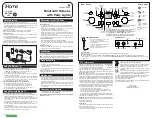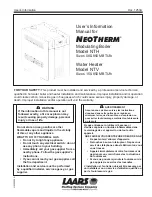
G. Surround Requirements
As a general rule, the total ensemble of surround loudspeakers should be capable of
producing as much acoustical power as a single screen channel. Today, the new JBL 8340 surround
loudspeaker is capable of producing total acoustical power output in the range of about 2 watts. Since
a typical dual woofer JBL screen loudspeaker is capable of producing continuous acoustic power
output of 28 watts, it is clear that 14 of the
will be required for power matching. Typically, in a
large house, 12 units will suffice. The careful designer should not go below this quantity.
The enclosure of the 8340 is similar to the older 8330, and the baffle has a downward slope of
making it possible to mount the rear of the enclosure flush with the walls, while providing smooth
coverage over the seating area. Generally, four of the units are placed on the back wall and four each
on the side walls.
Good surround operation depends on ‘a significant quantity of insignificant sources.’ That is to
say, a patron in the cinema should not be able to identify any one unit, but rather sense the sound
by all of them. While practice may vary, the surround loudspeakers are generally
mounted only in the back two-thirds of the house. The height is often dictated by decor, but they
generally should be at a height of 3 to 4 meters (10 to 13 feet), so that the tilted axis of the 8340 is
pointed at the farthest patrons across the cinema. When this is done, the smoothness of surround
response in the cinema can be maintained within 2
Details of surround location are shown in
Figure 23.
A. Plan View
Elevation View
C. Section View, as seen from
back of cinema
Figure 23. Plan, elevation, and section views of typical surround installation














































